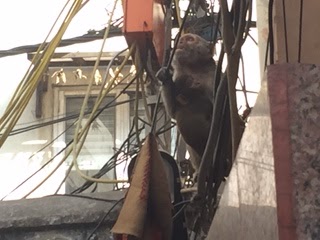India
I'm in India this week—part business and part pleasure.
The business part occurred in New Delhi, a a city of 25 million people (!!) with commensurate traffic and crowding. It's a cliche to state the New Delhi mixes the 21st century with an older time—modern (but relatively small) office buildings in the sprawling technology sector (where I worked) with the "old city" that is very 18th century. In the old city, you encounter narrow, twisted streets, thousands of tiny commercial stalls selling everything from spices to prayer beads to mobile phones, and far too many stray dogs (and a few stray cows), far too much garbage, and more than a few beggars, juxtaposed against vibrant color, thousands of honking motor bikes, and urban electric system that is ... well ... 'home brew' with millions of random wires handing from tall poles and buildings (with an occasional monkey doing the work of a utility lineman). It is difficult to describe adequately.
New Delhi is an object lesson for those who advocate better care of the environment. Pollution is serious—very serious—with a smog layer that blots out the sun in the early morning and creates a noticable level of harshness in the air. India realizes that something must be done, but the Paris climate change conference is thought of as a joke (it is, despite what the Obama White House tells us). India is beginning to take active and pragmatic measures (that have nothing whatsoever to do with Paris) to address the issue.
The young people working in IT are a credit to both the education system in India and to the enthusiasm of the young. Enthusiastic, dedicated and smart. Did you know that there is generally no vacation time (except for national holidays) in many companies in India? Probably because there are millions upon millions of educated job seekers who really must compete for the best jobs.
Touring began in the ancient city of Varanasi, the spiritual center of the country and of Hinduism. The city of 3 million, Varanasi is the old city of Delhi on steroids. Visited by millions of the Hindu faithful, it is the place for ritual bathing in the Ganges river and visits to one of 25,000 (!!) Hindu temples. Traffic on its narrow streets is indescribable mainly because there are hundreds of thousand of vehicles, almost no traffic lights or stop signs, and a demolition derby feel to it all (but without the crashes).
In fact, it's the traffic in Varanasi that caught my attention. Somehow Veranasi's drivers have developed a self-organizing system of managed chaos. Drivers use the horns as sonar, communicating every few seconds with other cars, motor bikes, auto-rickshaws, rickshaw, pedestrians and thousands of cows. They miss each other when coming into a roundabout or intersection by inches (literally) yet somehow know when to yield, when to bull through, and when to be careful (rarely!). It works and I'm not sure why.
On many streets, cows (which are sacred in India and cannot be harmed) become the the center dividers, lying along the centerline of a road. The reason is that the passing cars swirl the air and keep flies away from the cows. Looks like the bovines have self-organized as well.
Varanasi is dirty, old, and absolutely fascinating. It is an example of the benefits of small government while at the same time illuminating the problems of government that is too small.
I'll try to report on my travels again next week.
A few pictures might be worthwhile:
The Old City in Delhi:
A monkey "lineman" in the old city:






<< Home